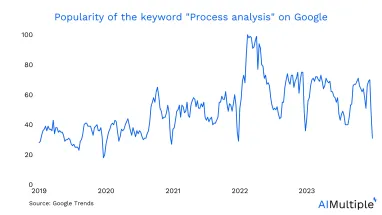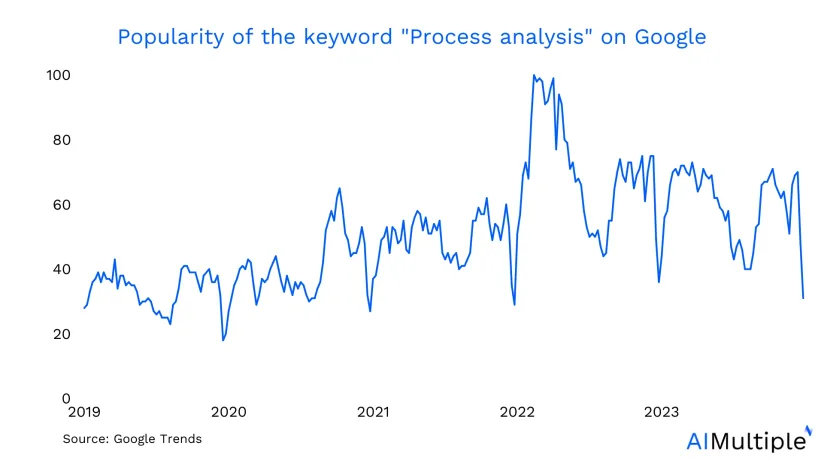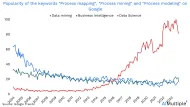3 Reasons to Apply Process Analysis in Your Business in '24


Business leaders engage in process improvement and automation projects so that they can improve their performance and customer satisfaction. However, analysts and leaders should comprehend their processes as they are before implementing any change. Yet, the first step is often a big challenge for the companies with complex processes.
Process analysis can overcome the challenge by evaluating the process in-detail and mapping it out. In this article, we’ll explain what process analysis is, 3 benefits it offers and why process mining is a relevant tool for process analysis.
What is process analysis?
Process analysis, also known as business process analysis (BPA) is a method to evaluate a process and find areas to improve in an organization. It allows analysts to document each step in their operations, track their workflow and address task inefficiencies. As a result, they can achieve higher efficiency in their business.
For instance, process analysis can be applied to the travel request approval process to map out the steps taken to approve the request, displaying the time and cost it creates for each approval process.
Process analysis is done through 7 steps:
- Identify a process: Prioritize a process that will deliver you the highest revenue, is newly implemented, requires review and standardization, or calls for an urgent redesign due to high cost or low customer satisfaction.
- Collect data about this process: Gather relevant information such as flowcharts, files & documents, people involved, KPI metrics etc. Consider deploying process mining to extract real-life data seamlessly.
- Visualize the process flow: Leverage the data to create a process map or flowchart containing all steps in order. Detailed maps can help increase understanding of the given process. While creating a map, use one of the recommended tools to fasten the stage. If you are using process mining to collect data, no need for a different platform because process mining visualizes the processes based on real-life data.
- Analyze the operations and tasks: Evaluate the process operations and tasks according to KPIs. Follow these three aspects:
- Detect and remove the redundant and unnecessary steps in the process.
- Identify delayed cases and see the components that take longer than expected and the resources or technology needed to prevent these.
- Assess the level of resource allocation and costs for each step to reduce cost, implement automation and increase efficiency.
- Remember that process mining discovers processes and runs conformance checks against process KPIs to facilitate the analysis step in the process analysis.
- Develop an ideal model: Use the analysis and process visuals to develop an ideal model that can perfect the existing process. Consider using a process modeling tool, a simulation or DTO capability to design the ideal model. Remember some process mining vendors offer DTO capability to evaluate scenarios to assess the ideal one. Many of these vendors allow users to upload ideal models generated with process modeling tools to compare their progress against the ideal model later.
- Implement the ideal model: Develop a strategy targeting to improve processes based on the ideal model. Involve relevant personnel such as HR teams if the changes are related to employees or IT teams for automation opportunities.
- Re-evaluate the final model: Constantly monitor the change you implemented and check for alignment. Remember that it is essential to go back and re-do the initial analysis or update the map. You can use process mining for re-evaluating purposes, as well.
What are the process analysis tools?
Analysts use flowcharts, diagrams or process management software (e.g. process modeling tools) that can streamline process analysis. More modern approach is to analyze processes with process mining because it helps , businesses:
- Automatically discover their actual processes,
- Map the process with advanced visualization capabilities,
- Compare the conformance level between intended and real process models,
- Identify deviations and inefficiencies with their root-causes.
Why is process analysis important?
Benefits that Process analysis provides to increase process efficiency include:
1. Address the bottlenecks
Although businesses set policies and rules for each process, there can be unclearities and unexpected situations, confusing employees to complete the process in time. For example, for a procurement process, employees can send the order to the wrong person, causing delays and reducing customer satisfaction. Yet, these issues are challenging to spot because the processes involve different parties and tasks.
Process analysis allows business analysts to dig into such processes and map their entire process flow. Therefore, analysts can easily identify the potential reasons behind the inefficiencies. They can identify the step causing the delay and address the issues.
2. Discover automation opportunities
Each business process includes manual tasks that are time-consuming and low value-added, such as filling out purchase order forms. By automating such manual tasks, business leaders can achieve higher productivity, save more time and decrease employee churns.
Process analysis can help you to discover manual tasks that slow down the processes. By automating manual tasks, you can save time and decrease human errors.
3. Reduce operational cost
Any deviation from the intended process model, bottleneck in the operational flow or manual task can increase the operational cost. For example, the bottlenecks and manual tasks in the purchase order step of the procurement process extend cycle time and consequently increase costs.
Process analysis enables analysts to reduce operational costs while increasing operational efficiency. With process analysis, companies can have a better understanding of their costs and target inefficiencies and manual tasks that have the highest costs.
Further reading
If you are interested in improving and managing your processes, check out our guides and best practices:
- How to Implement Process Improvement in 6 Steps?
- Pair Methodology with Technology for Process Improvement
- 5 Best Practices for Processes Management in 2022
If you want to leverage a process mining tool, review our data-driven comprehensive vendor lists.
Effectively analyze your process by leveraging easiest workflow and process management tools, such as:
- Workflow management software
- Business process management software
- Low-code/No-code development platform
- Onboarding software
Assess different vendors with a transparent methodology yourself by downloading our checklist:
And, if you need more help, let us find you the right vendor:


![55 Process Improvement Case Studies & Project Results [2024]](https://research.aimultiple.com/wp-content/uploads/2020/06/process-improvement-case-studies-190x107.png.webp)
Comments
Your email address will not be published. All fields are required.